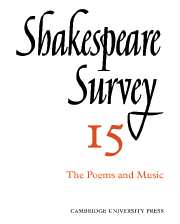Book contents
- Frontmatter
- Twentieth-century Studies in Shakespeare's Songs, Sonnets, and Poems
- Songs, Time, and the Rejection of Falstaff
- Shakespeare’s Sonnets and the Elizabethan Sonneteers
- Love’s Confined Doom
- Beasts and Gods: Greene’s Groats-worth of Witte and the Social Purpose of Venus and Adonis
- From Shakespeare’s Venus to Cleopatra’s Cupids
- Venus and the Second Chance
- Some Observations on The Rape of Lucrece
- An Anatomy of The Phoenix and The Turtle
- Shakespeare and the Ritualists
- Illustrations of Social Life IV: The Plague
- The Soest Portrait of Shakespeare
- International Notes
- Shakespeare Productions in the United Kingdom: 1960
- S. Franco zeffirelli’s Romeo and Juliet
- The Year's Contributions to Shakespearian Study 1 Critical Studies
- 2 Shakespeare’s Life, Times and Stage
- 3 Textual Studies
- Book Received
- Index
- Plate Section
Songs, Time, and the Rejection of Falstaff
Published online by Cambridge University Press: 28 March 2007
- Frontmatter
- Twentieth-century Studies in Shakespeare's Songs, Sonnets, and Poems
- Songs, Time, and the Rejection of Falstaff
- Shakespeare’s Sonnets and the Elizabethan Sonneteers
- Love’s Confined Doom
- Beasts and Gods: Greene’s Groats-worth of Witte and the Social Purpose of Venus and Adonis
- From Shakespeare’s Venus to Cleopatra’s Cupids
- Venus and the Second Chance
- Some Observations on The Rape of Lucrece
- An Anatomy of The Phoenix and The Turtle
- Shakespeare and the Ritualists
- Illustrations of Social Life IV: The Plague
- The Soest Portrait of Shakespeare
- International Notes
- Shakespeare Productions in the United Kingdom: 1960
- S. Franco zeffirelli’s Romeo and Juliet
- The Year's Contributions to Shakespearian Study 1 Critical Studies
- 2 Shakespeare’s Life, Times and Stage
- 3 Textual Studies
- Book Received
- Index
- Plate Section
Summary
Any inquiry into the functions of the songs in Shakespeare’s plays should be based on some consideration of what songs and music meant to Shakespeare and his contemporaries. Three points need to be kept in mind. First of all, Renaissance Englishmen knew a great deal more about music—especially its technical and social aspects—than do most people today. That Shakespeare’s England was ‘a nest of singing birds’ has been pointed out by scholars with the wearisome regularity that only such a crystalline phrase can acquire. The famous metaphor is intended not only to connote the deep interest that music held for Elizabethan Englishmen, but also their strong impulse to lyric poetry at a time when those arts were not so separated as they are today. The songs in Shakespeare’s England ranged from the madrigals, canzonets, and airs of the upper classes to the carols, cozier’s catches, and street-songs of the lower orders of society. The astonishing volume of poetry produced in that era was swelled not only by courtly sonnets but also by broadside ballads. Consequently it seems fair to extend the famous metaphor a little by saying that while those singing birds included among them many nightingales and larks, they also included a goodly number of choughs, rooks, and daws.
- Type
- Chapter
- Information
- Shakespeare Survey , pp. 31 - 40Publisher: Cambridge University PressPrint publication year: 1962



